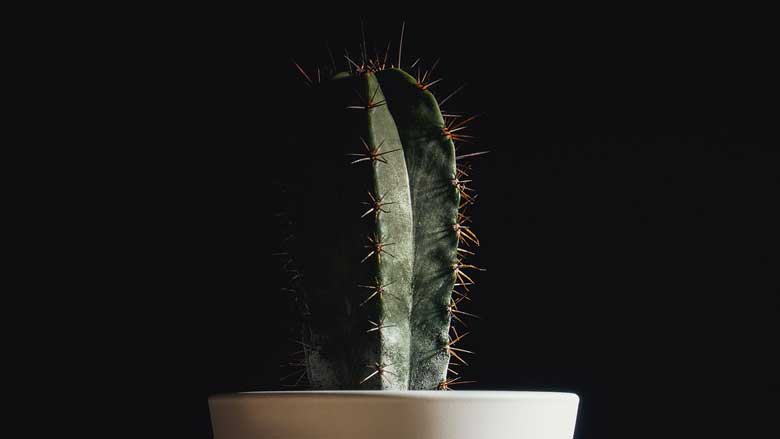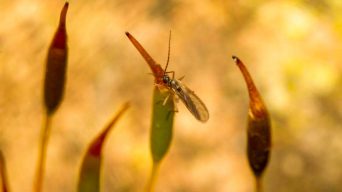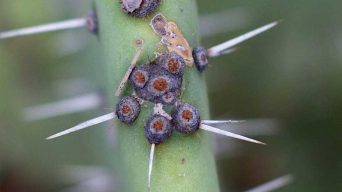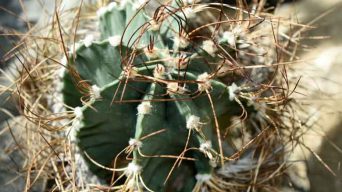Fungal infections in cacti, often seen as white mold at the base, stem from overwatering, humidity, and poor soil. Identifying and addressing the issue promptly is crucial. Prune affected areas, and use baking soda solutions or fungicides. Prevention involves proper drainage, sunlight, and timely removal of diseased parts.
Cactus plants stand out for their distinctive appeal and low maintenance, making them captivating and exotic enhancements to any setting.
However, despite their simple care requirements, they are susceptible to fungus if neglected.
Treating fungus on cacti is challenging, requiring patience and meticulous care for effective eradication.
In this article, we will explore the reasons behind fungal problems in cacti and provide detailed instructions on how to resolve these issues permanently.
Identifying Fungus on your Cactus Plant
A commonly known condition affecting cacti, white fungus, appears as a soft, white mass, typically found at the base of the plant. If the infection progresses, it can reach the stems and roots.
The fungus often resembles cottony mold, mainly when it develops over decaying plant material like fallen leaves or flowers. Typically, the infection initiates in decomposing plant matter and then advances to affect live parts of the plant.
In instances with no apparent signs of other damages, it can be challenging for an inexperienced observer to distinguish the presence of fungus from other potential issues with their cacti.
Factors Contributing to Cactus Fungus
Fungus growth in a cactus can be attributed to various factors.
Excessive humidity is a prevalent cause, creating a damp environment conducive to fungal development.
Improper watering practices, particularly overwatering, can result in root rot, representing another potential source of cactus infection.
1. Overwatering
One of the most common causes of fungus on a cactus plant is overwatering.
This can happen when there are heavy rains, and it would be expected to water your plant, but you overdo it with too much water at once.
The same happens if you have a drainage problem or poor soil that doesn’t allow proper draining after watering.
If this happens, fungi will begin growing because the roots start rotting from being soaked continuously with water. Loose Soil Conditions
If your potting mix isn’t very good, the fungus may grow even if you don’t overwater your plants since they aren’t getting adequate nutrients!
Get some quality potting soil (with lots of drainage), or research to see other options.
2. Humidity
Humidity can become an issue if your plant is in a small pot.
This means there isn’t much space for air to circulate the roots and cause them to stay moist instead of drying out.
Cactus issues can arise in such conditions, as these plants are particularly sensitive to excess moisture and need proper airflow to thrive.
In this case, you might see fungus beginning to grow on top of the soil or even near its base, where it sits inside the pot.
If this happens, try repotting into a bigger container with better drainage, but also be sure not to take care of overwatering since cactus plants need less water in larger containers!
3. Temperature Issues
Temperature issues could have something to do with why your cacti have developed fungus, though!
Cacti prefer warmer climates, so if you experience colder temperatures, fungi could become a problem.
If you see this happening, moving the cactus into an area with more light and heat to grow nicely is best!
4. Excessive Fertilizer Use
Excessive fertilizer application can contribute to the development of fungus in cacti.
Optimal fertilizers for cacti feature low levels of nitrogen and potassium. Ensure the selected fertilizer is not overly acidic, as indicated by the pH level.
Using fertilizers with high nitrogen and potassium content or inappropriate pH levels may have adverse consequences.
In such cases, the cactus may experience burning, resulting in deformation and abnormal growth patterns or colors. Balancing fertilizer use to prevent these issues and promote the plant’s overall health is crucial.
5. Cactus Age and Condition
Your cacti may not be as healthy anymore because of their age or condition.
When cacti age, their growth slows down, and leaves begin to fall off without any reason (this doesn’t mean anything – don’t worry).
It could be because the roots can’t absorb nutrients like before since they are getting old.
This means that fungus might appear on top of soil or near the base if it grows from rotting roots due to over-watering.
If this happens, it’s best to repot the cactus into a bigger container with more drainage and better soil quality!
6. Diseases
Some fungal diseases, like powdery mildew or botrytis, can occur on cactus plants, typically growing from overwatering.
For these conditions, you will see leaves turn brown and curl up at the top of your plant where there isn’t any green color left, instead of just white mold growing on top of the soil or near the base.
In cases like this, immediately remove all affected areas so they don’t spread – do not water for two weeks either since fungal spores could still be inside new parts without showing signs of it.
Types of Fungi that Affect Cacti
Different types of fungi can affect cactus plants. These include:
1. Powdery Mildew
The cactus leaves may turn yellow or brown, and its growth will be stunted if left untreated.
Powdery mildew is caused by fungi in the family Erysiphaceae, which produce powdery white spores on the foliage, flowers, stems, and fruit surface.
These spores spread via wind or rain splash to infect other plants nearby.
This disease does not require water (such as dew) for germination but needs humidity levels above 75 percent to grow well.
2. Downy Mildew
This fungus will cause the leaves to develop yellow spots.
Eventually, these areas become covered with a fine, downy white fungal growth, which can be seen from a short distance in the early stages.
The plant may also have black fungal lesions if infected by Phomopsis leptostromiformis or gloeosporioides fungi species that produce reddish spores and greenish-grey pustules, respectively.
4. Leaf Spot
This fungus causes dark spots on the cactus leaves, which become significant brown areas with a white or greyish center.
These spots may also have purple or brown borders and increase in size as the infection progresses.
The plant will become bleached and distorted if this fungus is left untreated.
5. Rust
Rust fungus is a common issue affecting cacti, manifesting as unsightly orange or yellowish bumps that create rust spots on leaves and branches.
These distinct spots are caused by fungi from the Puccinia genus, spreading through various means such as windblown spores, rain splash, insects, animals, and even through garden tools and clothing that come into contact with the plant.
Beyond the cosmetic concern, rust spots significantly threaten the cactus’s health and growth.
6. Root Rot
This fungus causes cacti to develop brown patches on their roots, often surrounded by a yellow halo.
It is caused by fungi species in the Phytophthora that spread through spores carried into the soil via wind, rain splash, or garden tools brought into contact with infected plants.
7. Anthracnose
These fungi produce pinkish spores, and their infection results in tiny circular, angular, oval, lobed, or irregularly shaped lesions on both sides of the leaf blades.
As Anthracnose fungus disease progresses, it may cause defoliation in the most severely infected parts of succulents, leading to premature foliage loss and stem damage.
This damage is often the result of the fungus encircling vascular bundles near the junctures of branches and stems, disrupting the plant’s vital systems.
Effective Methods for Treating Fungal Infections on Cactus Plants
Dealing with fungi on cactus plants can be bothersome, but several effective methods can help eliminate the issue.
Method #1: Prune Infected Areas
Initiate the treatment by removing the affected parts of the cactus using a sterile knife or clippers.
After removing the infected parts, it’s vital to maintain proper air circulation around the plant. This assists in healing the wounds and hinders any further development of the infection.
Following this, apply a fungicide to the healthy sections every two weeks for six to twelve months, depending on the chosen fungicide.
To foster growth and prevent future outbreaks, adhere to the fertilizer application guidelines provided on the package.
Consistently maintain proper watering throughout this period; avoid letting the soil dry out ultimately between waterings, as excessive moisture may lead to root rot issues and black spots.
Method #2: Use Baking Soda and Hydrogen Peroxide
A widely employed approach involves preparing a solution using baking soda (sodium bicarbonate).
To create this solution, mix two teaspoons of baking soda with one quart of lukewarm water and then transfer the mixture into an empty spray bottle.
Thoroughly spray your cactus plants, ensuring coverage on both the undersides and tops of leaves, especially when you observe leaf spots indicating the onset of a fungal attack on your cacti.
Repeat this process consistently at least twice a week for six weeks. This regular application is key to effectively eradicating fungus from your cactus plants.
Method #3: Make Your Homemade Solution
In cactus care, combating fungal issues is essential, and one valuable approach is creating your own treatment.
To concoct this homegrown remedy, combine one tablespoon of baking soda, hydrogen peroxide, and liquid soap with a gallon of water in an empty spray bottle. This custom blend serves as an effective cactus mold treatment.
Before applying the solution, ensure your cacti are in clean pots, as this helps prevent further fungal growth by maintaining a healthy environment for your plants.
Spray this solution liberally onto your cacti every two weeks for at least six months. Doing so will ensure your cactus receives the necessary treatment, eliminating the problem plaguing your cacti.
Method #4: Spray With White Vinegar
A third option is to mix one part white vinegar (or apple cider vinegar) with four parts water in an empty plastic container or bucket.
Carefully dip the leaves into this solution until they are thoroughly saturated but not dripping wet.
Allow them to dry without rinsing off any remaining fungicide that may have adhered to the surface. Notably, less than half of the fungicide will be removed during rinsing, making it better to leave it as is.
This solution should be used within a week if you make it yourself. If you buy it, store it in a cool, dry place.
Method #5: Cleaning with Soap and Water
A simple and effective method involves regularly cleaning your plant with soap and water, ideally daily or every other day, especially after any activities around them that may result in dust accumulation.
Dust acts as an insulator, shielding fungi from drying out. Therefore, as described in method three, wiping off dust before applying fungicide is crucial.
This practice addresses existing issues and is a preventive measure against future fungus outbreaks in cacti.
To implement this method, spray all leaves, including the undersides, with a solution comprising one tablespoon each of baking soda, hydrogen peroxide, and liquid soap mixed in two quarts of lukewarm water.
Method #6: Using Commercial Solutions
When faced with a severe infection on your cactus, employing fungicides under proper control is a viable solution.
Various fungicides are on the market, each with its efficacy and specific purposes. It’s crucial to select the one that aligns with your particular requirements.
It’s important to note that even if only a couple of leaves exhibit symptoms, promptly applying the fungicide is imperative. Failing to do so may result in the rapid spread of the disease throughout the entire plant unless addressed assertively in the early stages.
Preventative Measures Against Fungal Infections on Cactus
Preventing fungus infections on cactus plants involves taking proactive measures. Here are vital tips to follow:
- Optimal Sunlight and Well-Draining Soil: Ensure your cactus is placed in a sunny spot with soil for proper drainage.
- Watering Practices: Water only when the top inch or two of the soil is dry. Utilize room temperature rainwater whenever possible, and avoid overwatering.
- Adequate Pot Drainage: Ensure proper pot drainage to keep the soil dry, mainly when cultivating cacti indoors. This step is crucial in preventing fungal growth.
- Timely Removal of Diseased Parts: Promptly remove any dead or damaged sections of the plant to prevent the spread of the fungus.
- Sterilization of Tools: Always sterilize your tools before and after use when repotting cacti.
- Gloved Protection: Avoid direct contact with the plant using bare hands. Wear gloves when handling cactus soil or potting mix to prevent the spread of fungus through your skin.
Final Thoughts
Fungal infestation on cactus plants is prevalent, prompting many to use organic remedies in their gardening.
This concern extends to succulents, which share similar environments and are equally susceptible to fungal diseases.
However, this may not always yield optimal results. Regular use of fungicides and chemicals might lead to the development of resistance in cacti and succulents.
An integrated approach, combining both chemical and organic solutions, is recommended. What proves effective for certain fungi may not be as successful for others.
To proactively prevent infections, it is advisable to cultivate an environment less conducive to fungus growth.
Optimal conditions can be achieved by placing cactus plants in a sunnier location, as some fungi thrive in damp and shady settings.
Moreover, ensuring well-drained soil around the cactus prevents prolonged moisture exposure, a critical step to prevent fungal growth.
Adhering to these steps can effectively address fungal issues on your cacti.







